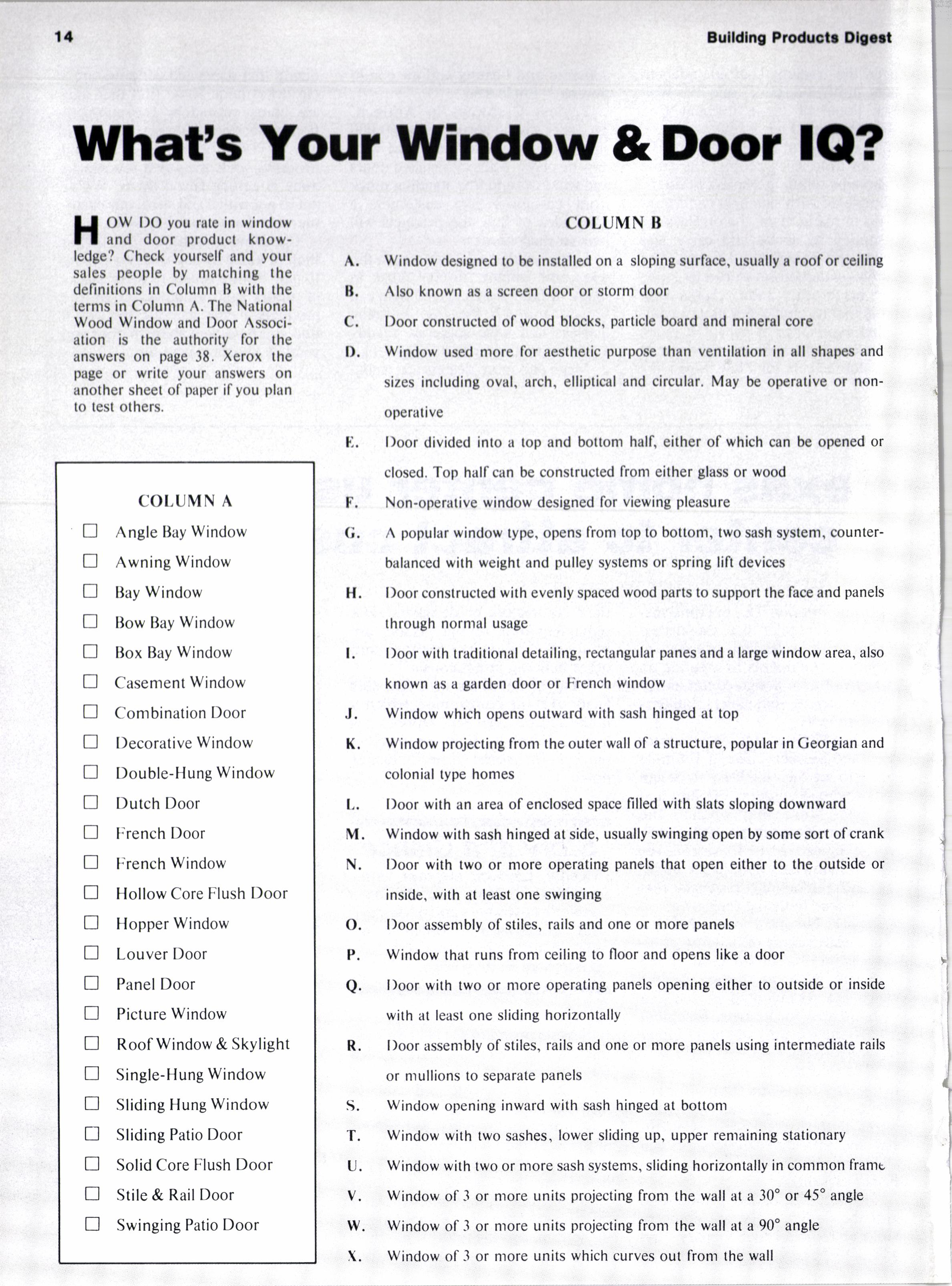
2 minute read
What's Your Window &Door lQ?
OW l)O you rate in window and door product know-
Column B
A. window designed to be installed on a sloping surface, usually a roof or ceiling sales people by matching the definitions in Column B with the B. Also known as a screen door or storm door terms in Column A. The National Wood Window and Door Associ- ledge? Check yourself a1d v9.ur
C. Door constructed of wood blocks, particle board and mineral core ation is the authority for the answers on page 3g. ierox the
D. window used nrore for aesthetic purpose than ventilation in all shapcs and page or write your answers on _! another sheet of pop., ir'iJu'prin sizes including oval. arch, elliptical and circular. May be operative or nonto lest others. operative t:. l)oor divided into a top and bottom half, either of which can be opened or closed. Top hallcan be constructed from either glass or wood
Column A
Angle Bay Window
Awning Window
Bay Window
Ilow Bay Window
Box Bay Window
Casement Window
Combination Door
Decorative Window
Double-Hung Window
Dutch Door
F-rench Door
French Window
Hollow Core FIush Door
Hopper Window
Louver Door
Panel Door
Picture Window
Roof Window & Skylight
Single-Hung Window
Sliding Hung Window
Sliding Patio Door
Solid Core Flush Door
Stile & Rail Door
Swinging Patio Door
F. Non-operative window designed for viewing pleasure
(;. A popular window type, opens from top to bottom, two sash syslem, counterbalanced with weight and pulley systenrs or spring lift devices
H. l)oor constructed with evenly spaced wood parts to support the lace and panels through nornral usage l. l)oor with traditional detailing, rectangular panes and a large window area, also known as a garden door or French window
J. Window which opens outward with sash hinged at top
K. Window projecting lrom the outer wall of a structure, popular in Georgian and colonial type homes
1.. l)oor with an area of enclosed space filled with slats sloping downward
M. Window with sash hinged at side, usually swinging open by some sort of crank
N. I)oor with two or more operating panels that open either to the outside or inside, with at least one swinging
O. l)oor assenrbly of stiles, rails and one or nrore panels
P. Window that runs from ceiling to floor and opens like a door a. l)oor with two or more operating panels opening either to outside or inside with at least one sliding horizontally
R. l)oor assenrbly of stiles, rails and one or nlore panels using intermediate rails or nrullions to separate panels
S. Window opening inward with sash hinged at bottonl
T. Window with two sashes, lower sliding up, upper rentaining stationary
U. Window with two or more sash systems, sliding horizontally in conrnton lranrc
V. Window of J or nrore units projecting lronr the wall at a 30o or 45" angle
W. Window of J or nrore units projecting fronr the wall at a 90' angle
X. Window of J or nrore units which curves out fronr the wall ll AJOR home center accidents, lUl especially those resulting in death, create headlines, but small mishaps that go unnoticed can be just as damaging. When a worker is injured on thejob, the consequences to the injured worker and the company can be enormous.
Although insurance may compensate direct losses due to injuries, indirect losses can cost companies one to ten times more than the direct cost ofthe injury, according to Janres Ptak, Fireman's Fund Insurance Co. He lists indirect costs as lost wages paid to an injured worker, time spent by workers discussing an accident and the drop in employee morale which may result in poor performance.
The bottom line, as he sees it, is it is good business to prevent work related injuries. A safe workplace results in smoother workflow, increased productivity and higher profit margins.
Employers who merely give lip service to the issue of worker safety accomplish little, Ptak points out. The only way to ensure success of a safety program is to elicit the support of management and educate employees on the benefits of the program.
When developing a worker safety plan, it is important to renrenrber that accidents don't occur spontaneously. They are caused by work related conditions. Ptak lists the










